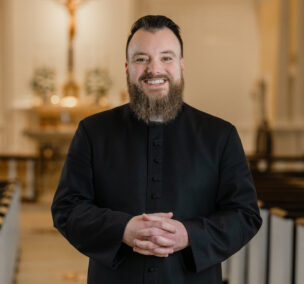Dear Brothers and Sisters in Christ,
This week I will begin with a story that I found very uplifting. One day last week after morning Mass, a woman stopped to tell me something about the gates of our new altar rail. She remembers them in a deeply personal way from her youth. She confirmed that they came from an orphanage in Brooklyn and then said, “Father, when I was a. teenager, I used to volunteer there and help the Sisters. My father would bring me over and I would help take care of the children, with school work, with prayers in the chapel. And to see those gates now is so lovely!” Now, years later, she finds those same gates that once adorned the sanctuary of the chapel where she put the Gospel into action by caring for orphans present in her parish church, where she has put the Gospel into action caring for her family and community!
All of which reminds me that our actions, especially liturgical actions, carry a weight of influence in other aspects of our lives. There is a saying in theology: “Lex orandi, lex credendi.” In other words, the law of prayer is the law of faith. The way we pray influences what we believe. Take, for example, our signs of reverence upon entering the church, or our reverence for Jesus in the Eucharist. These physical postures and gestures of prayer reflect an interior, prayerful reverence in the heart. As we cultivate that reverence, our faith in God’s goodness, glory, and worthiness is enhanced. When we kneel in prayer – the natural prayer position for Christians, at least in the West (in the Eastern/Byzantine rites of the Catholic Church, their ancient practice in liturgy is to stand, but to make such profound bows that their hands touch the floor) – we place ourselves in a physical position of vulnerability and humility before the Lord. This prayerful posture cultivates the belief that God is the one on Whom we rely for all blessings and gifts. When we kneel during the Eucharistic prayer, or genuflect while passing the Tabernacle, we are demonstrating with prayerful gesture what we believe to be true – that Jesus Christ is present, Body, Blood, Soul, and Divinity in the Eucharist.
The Gospel that we hear at Mass is meant to be put into action in our lives. We begin that action at every Mass, and from the Mass, go forth into the world to put it into action in our daily lives. We return again and again to the Mass to be renewed in the Gospel charge to serve, to heal, to teach. Our reverence, particularly for the Eucharist, ought to inspire our reverence toward our neighbor and our world. The prayerful postures we adopt ought to be a reminder that we believe in the dignity of every human life, that we know there to be a God above us whose Wisdom and Knowledge surpass our own, that our hands are best used in service to the most vulnerable rather than in service to self. While we may not genuflect to family members, fellow students, or coworkers, we can cultivate a reverence toward them that allows us to see their true dignity and reflects their infinite worth in the eyes of God. Our liturgical and prayer postures have a proper place and role when we are at Mass or prayer. Their effect, though, is meant to last long after we have left the church, long after we have finished our prayer, long after we have received the graces of the sacraments. Their effect is meant to be carried in our hearts. So genuflect well when you come into church. Kneel well during the consecration, kneel well at the altar rail (before or after Mass, or even to receive Holy Communion!), kneel well in thankful prayer. Listen attentively as the word is proclaimed. Listen attentively as the Lord speaks to your heart. Then go forth in peace. Go forth to reverence Jesus as he is found in your neighbor, your enemy, the poor, the marginalized, the sick, the annoying, the odd. Go forth so that what you have heard with such attention may echo through your life for all to hear.
Peace,
Fr. Sam


